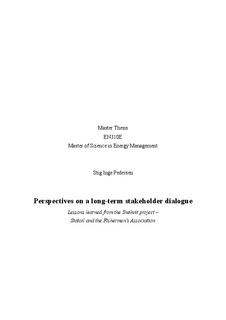| dc.description.abstract | The point of departure for my research is to conduct a case study of Statoil's stakeholder
approach from the establishment of the Snøhvit project until the current situation in Nordland
VI, VII and Troms II. This research is based on the communication process that evolved
between Statoil and the Fishermen’s Association from the initial contact regarding the
Snøhvit1 project up to a pending situation for coexistence on waters off Lofoten Islands.
Anyone who has followed the media focus on the topic of coexistence in the waters off the
Lofoten Islands will understand that this is a major challenge to an oil company’s stakeholder
approach. The Fishermen’s Association represents a major stakeholder and claims its rights
and respect from the oil industry based on its long-lasting history of operating in these waters
without interference. A passionate debate has evolved ranging from the view of the fisheries’
rights to these marine resources to the fear of negative environmental impact due to oil
activity in these waters. The pending political decision, based on the fisheries’ position, the
authorities’ advice, NGOs and general public opinion, may finally lead to an opening for oil
activity in these waters in the near future. My curiosity regarding the fisheries’ different
attitudes for coexistence to different waters encouraged me to conduct a qualitative research
to interpret meanings and different constructions of my respondents experiences, thus reveal
aspects of Statoil's stakeholder approach.
As demonstrated in my findings, Statoil’s interaction with different social networks managed
to externalize knowledge and understanding that modified attitudes in this key stakeholder,
which internalized this as trustworthy. Derived from my findings, it emerged that Statoil was
collaborating with the Fishermen’s Association based on deliberate strategies, where its
purpose was solely to develop conditions for good establishment and coexistence in the
Barents Sea. My findings demonstrated that Statoil’s social interaction with the Fishermen’s
Association corresponds with its stated obligations. The management team from Statoil
managed to develop a long and continuous dialogue with this stakeholder during the
establishment of the Snøhvit project, all the way to the end.
Derived from my findings it appears that Statoil have considered their perspective on their
stakeholder approach. My findings indicate that a long-term dialogue with local stakeholders
should be considered beyond a one-by-one project, which could ease their access to more
sensitive fields. | en_US |
